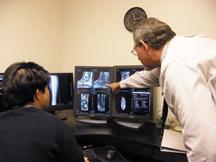
We wanted a mature, Web-based PACS that enabled all authorized clinicians to access images at any time without incurring additional licensing costs, said Kathy Korbholz, vice president of ancillary operations, Palo Alto Medical Foundation (PAMF).
Buyer behavior and purchasing patterns evolve over time, particularly for capital equipment and information technology. What was important in the purchasing decision five or 10 years ago may not be today, as environmental, operational and technological changes impact the decision-making process.
PACS is no different. Ten years ago, creating a filmless environment and justifying the return-on-investment (ROI) were important PACS-buying considerations. Now that getting a short-term ROI on a first-time PACS is a given, and since the U.S. PACS market has matured, many hospitals already have implemented some degree of filmless radiology. According to a 2007 article by RCG Healthcare Consulting states that more than 30 percent of U.S. hospitals are fully digital with PACS.1
“As technology changes and vendors build systems differently than in the past, customers [should not] keep specifying the same old products,” said Shelly Fisher, president, BRIT Systems. “Large, relational databases are being replaced by Java.”
One mistake that we continue to see in the market, indicates Mike Cannavo, PACS consultant and president of Image Management Consultants, is that many facilities buy based on price. “The biggest issue is whether or not it meets the facility’s particular needs,” said Cannavo. “In this economy, vendors will modify their price, and so this shouldn’t enter into the equation.”
Jim Holder, director of Imaging Services for Palo Alto Medical Foundation (PAMF), a multi-specialty healthcare provider that installed iSite PACS by Philips Healthcare, agrees. “Don’t just seek out the lowest cost solution. Remember that you are building a system that needs to work with ancillary solutions such as HIS, RIS, as well as one that will grow with you,” he cautioned.
So what are the top five key buying considerations for a replacement PACS?
Integration and Interoperability
“Integration capabilities are very important. Pick a vendor who is highly technical, with a proven track record to connect various manufacturers and brands – from modalities to other information systems,” said Kathy Korbholz, vice president of ancillary operations, PAMF.
Even with DICOM and IHE, Cannavo says, there remains a lack of adherence to these standards. “The industry established these standards, but the real problem is there are no penalties for lack of compliance. If they don’t adhere, they shouldn’t be able to sell,” he said.
Fisher added, “One of the best ways to prepare for the future is to ensure your PACS supports industry standards.” Facilities need to understand their future direction and the role that PACS will play. “Will your institution support Google Health or other PHRs? Are there plans for a RHIO? Could you be supporting outside entities in some way?” she said.
Facilities should inquire if the PACS stores native DICOM advises Henri “Rik” Primo, director of marketing and strategic relationships, Image & Knowledge Management, Siemens Medical Solutions. “Find out if other DICOM viewers can be used to view the images,” said Primo. He also encourages asking whether the system enables HIPAA compliance.
For Nebraska Medical Center, interoperability was a key consideration when buying a new PACS. Chuck Lakso, administrative director of radiology, and Mike Battreall, manager of digital imaging, had to ensure their replacement PACS could integrate with a wide array of third party vendor software, including research and teaching applications. “Our radiologists wanted a PACS that allows them to do everything at one workstation, including 3D viewing,” said Lakso.
According to Eli Rapaich, vice president of sales, North America, Philips Healthcare, you should be sure to ask: “How does the vendor propose servicing and maintaining integration as both parties introduce new software releases?” he added. “Try and test how open the system is during site visits, including how well it integrates with an EMR.”
Take interoperability evaluations beyond RIS to encompass transcription and dictation, noted Steve Nevermann, senior PACS specialist, Merge Healthcare. “You will need to integrate other workflow solutions or clinical applications, and also determine if your institution will acquire more partners or patients and at what pace,” he advised.
The Archive
PACS data migration nightmares primarily exist because of the lack of DICOM archives. When data is stored in a proprietary format, the migration will likely take years to complete. Rapaich encourages buyers to inquire about other data migrations the vendor completed, and ideally, “find out how the vendor helped other sites transition from one PACS to another.”
The safest route, according to Cristine Kao, senior marketing manager, GE Healthcare IT Imaging Solutions Group, is to use a DICOM archive as the standard for communicating with all devices. “The archive should partition storage to better manage DICOM data that originates from departments beyond radiology, such as cardiology and visible light, or different vendors’ PACS. Keeping the archive separate from the PACS gives flexibility for future growth of the clinical application,” she said. “The future of PACS and its archive is intelligent patient data management,” explained Kao, “that maximizes efficiency in managing patient data and storage requirements.”
Another option that facilities might consider is the use of an Application Service Provider (ASP). At PAMF, Korbholz wanted to control storage costs as file sizes grew. iSite PACS offered her site an ASP, or fee-per-study, model that not only managed costs but also expanded with the practice.
The first PACS at Nebraska Medical Center had separate databases for radiologists and referring physicians. Now with Horizon by McKesson, one database exists for all exams for quicker access to patient images and reports. Radiologist productivity has increased by eliminating paper driven and fax dependent workflows. Battreall recommends involving the IT department to evaluate the PACS. “Are servers clustered with a warm spare in a secondary data center with no single points of failure?” he asked.
You should also inquire about the vendor’s capabilities to offer a comprehensive disaster recovery and business continuance program, and data center classification – tier one, two, three or four – based on the Uptime Institute’s industry standard approach to site infrastructure functionality.
Image Distribution and Workflow
PACS functionality directly affects productivity and workflow. Today image distribution is paramount to a fully filmless environment. You should consider what the workflow is from ED to radiology, from radiology to clinicians, noted Rapaich.
Fisher added that critical results reporting and ED discordance tools streamline and document communications between radiology and referring clinicians. A Web-based viewer, she added, is another important component for “anytime, anywhere access to patient images.” And, Web-based telephony tools can be used to automatically track down healthcare providers and delivery findings.
Since radiologists require quick access to all relevant priors and referring physicians need images available in exam rooms, at PAMF, enterprise image distribution was one of the most important considerations in selecting their replacement PACS. “We wanted a mature, Web-based PACS that enabled all authorized clinicians to access images at any time without incurring additional licensing costs,” said Korbholz.
For Holder, distributing images across 12 medical centers was critical for a completely filmless operation. Yet the biggest gain, he says, is the ability to better manage the “real estate” within the building. “This PACS allowed me to push radiologists out of a reading room and into their offices, and convert that centralized reading room into additional radiology exam rooms,” Holder said.
Nebraska Medical Center’s images are always available with approximately two years online and a spinning disk archive. “Our workflow is PACS-driven and archive centric,” said Lakso. “Completed studies are sent to the archive, and the tech QC’s the exam so it is ready for the radiologist.” This has also helped Lakso implement a nearly paperless radiology environment, as most documents are scanned at the technologists’ workstation.
Leverage Your People
Like the commercial says, “I’ve got people,” a hospital must have the right people in place for implementation, training, service and support. “Change is always difficult, so give people plenty of time to train and learn the new application,” said Fisher. “The good news here is that this is a much easier transition [to a new PACS] than going from film to PACS.”
“Make sure you have adequate real-time support and training for the install and go live,” Lakso stressed. “One of the biggest complaints we heard from the first install is the radiologists didn’t have enough help when they needed it most.”
Ask who will conduct the training. “Is it only the vendor, or will the facility utilize super-users trained by the vendor, who will then train the rest of the staff? Does everyone know the roles and tasks that he or she is responsible for?” said Primo.
Also, ensure the PACS team has the right consensus opinion, Cannavo added. “Is everyone on board with the decision, including the C-suite?” he asked.
Another tip is to utilize the knowledge that users have gained with PACS. “Ask what they like and dislike about the existing PACS. Use their experience to gain a broader view of your needs,” said Rapaich.
Choose Your Vendor Wisely
Make sure you are comfortable with the company, not just the financials but the people, the service and the sales. “Buyers must realize that PACS is like a five-to-seven-year marriage,” said Cannavo. “Follow your gut.”
Dig deep when it comes to vendor service and support, said Kao. “Are there remote support capabilities that can fix a problem before it occurs and how quickly can a field engineer arrive on-site if needed.”
Lakso recommends that potential buyers visit similar customer sites and ask them to show the workflow. “Be aware of vendors over selling a product; if it sounds too good to be true, ask them to prove it,” he advised.
Before singing on the dotted line, says Primo, make sure the vendor shows interest in your specific workflow and has listened to your key requirements. He also stresses finding out how long the vendor has been in the PACS/RIS market and what their existing customer profiles are. “Did they implement their system in sites that mirror your facility?” said Primo.
The bottom line, according to Nevermann, is “choose a vendor who can provide a consistent track record of well-orchestrated implementations, maintains industry standards and is active in healthcare initiatives. The vendor should understand your goals and approach the process with the vision, enthusiasm and dedication to create a true partnership.”
References:
1. Harlem PM. Going Filmless in Radiology: What is PACS and Why Does it Matter? CN-EZINE ARCHIVES, posted 2/4/2007.




 November 29, 2025
November 29, 2025 









